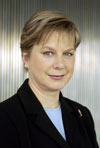12/17/2007
UK: London Congestion Charge Increases CongestionReport shows that despite millions raised through the congestion tax in London, UK, congestion is worse than ever.

The imposition of a tax on motorists entering central London, UK has failed to produce promised reductions in congestion, according to a report released last month by London Assembly Conservatives. London Mayor Ken Livingstone had promoted his congestion charge as the solution to gridlock in the downtown area where, in 2003, traffic crawled at an average rate of 10.6 MPH. Now that motorists are paying £8 (US $16) to enter the area, that figure has dropped to 9.3 MPH. A more accurate measurement of congestion that uses London's network of plate-reading ANPR cameras showed that "excess delay" nearly doubled from 0.87 minutes per mile in 2003 to 1.5 minutes per mile in 2006.
"Transport for London have admitted that congestion in the original central London zone is spiraling out of control," the Assembly Conservative report stated, citing TfL data (view TfL data in a 2.4mb PDF file).
The data illustrate a number of reasons that the tax has done little to ease the Londoners' commute. Once motorists have paid to enter the charging zone, they try to get their money's worth. This is one reason why the amount of driving within the zone is higher than ever. Moreover, in 2006 over 41 percent of vehicles entering the charging zone had some sort of politically favored vehicle entitled to an exemption from paying the charge. This is reflected in figures showing a significant increase in taxis, buses and mopeds within the central zone. Nearly all nearby roads reported added traffic jams from 2003 to 2006 as motorists sought to avoid the charge.
TfL's own report explained that much of the congestion within the zone was actually intentional. To discourage drivers from using the streets, Mayor Livingstone took away lanes from general traffic and designated them "bus only" after re-timing traffic lights to disturb the flow of traffic.
"The overwhelming balance of these interventions is towards those that would measurably reduce effective capacity of the road network for general traffic, thereby increasing congestion or traffic delays," the Transport for London report stated. "Few, if any schemes have an objective to increase local network capacity."
The congestion intended to drive motorists to take the bus had the contrary effect because buses became stuck in the same jams. The number of bus miles traveled in 2006 dropped 28 percent, with average bus speeds dropping 11 percent since 2003. Next year, the charge for certain vehicles entering the zone jumps to £25 (US $50). Conservative transport spokesman Angie Bray lashed out at Mayor Livingstone in a transport committee meeting during discussions of the first increase in the charge.
"It seems to me that you can bandy around any amount of bogus figures and all sorts of modeling you have done," Bray said. "Really, the truth is that what you are really after is more money... When would it be enough? It could be a case, in your terms, for saying, 'I could bung it up to £50' (US $100) and then nobody would come in. Would that be your perfect London? Or do you accept that there have to be vehicles at some level traveling around London? Where would you actually stop?"
A full copy of the assembly report is available in a 27k PDF file at the source link below.


